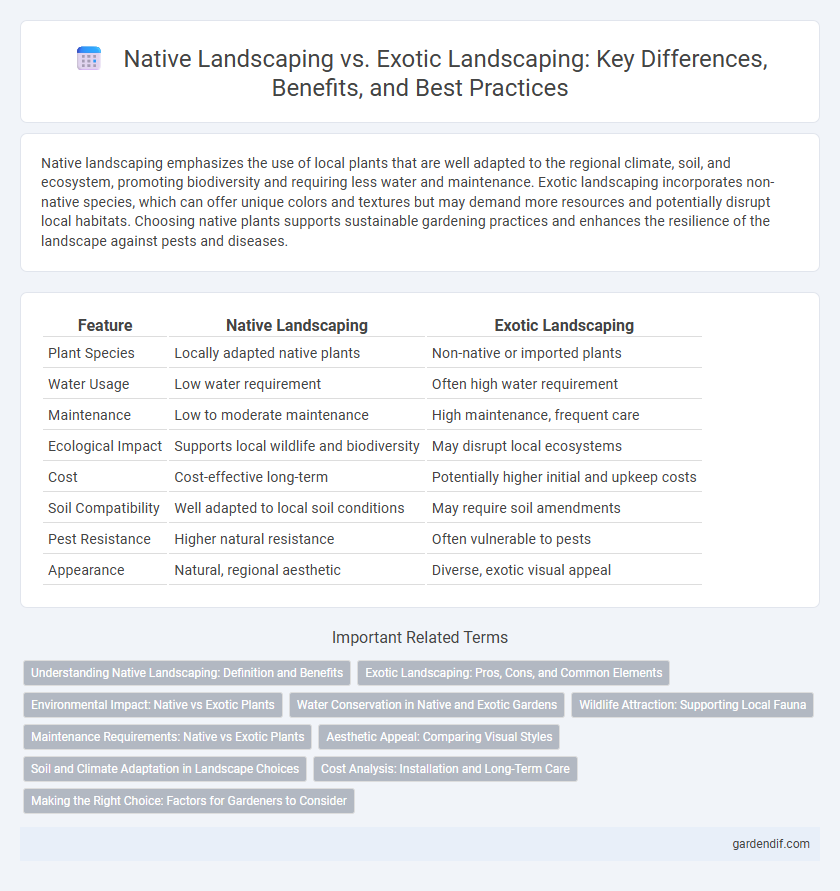
Native Landscaping vs Exotic Landscaping Illustration
Native landscaping emphasizes the use of local plants that are well adapted to the regional climate, soil, and ecosystem, promoting biodiversity and requiring less water and maintenance. Exotic landscaping incorporates non-native species, which can offer unique colors and textures but may demand more resources and potentially disrupt local habitats. Choosing native plants supports sustainable gardening practices and enhances the resilience of the landscape against pests and diseases.
Table of Comparison
| Feature | Native Landscaping | Exotic Landscaping |
|---|---|---|
| Plant Species | Locally adapted native plants | Non-native or imported plants |
| Water Usage | Low water requirement | Often high water requirement |
| Maintenance | Low to moderate maintenance | High maintenance, frequent care |
| Ecological Impact | Supports local wildlife and biodiversity | May disrupt local ecosystems |
| Cost | Cost-effective long-term | Potentially higher initial and upkeep costs |
| Soil Compatibility | Well adapted to local soil conditions | May require soil amendments |
| Pest Resistance | Higher natural resistance | Often vulnerable to pests |
| Appearance | Natural, regional aesthetic | Diverse, exotic visual appeal |
Understanding Native Landscaping: Definition and Benefits
Native landscaping involves using plants that are indigenous to a specific region, promoting ecosystem balance and biodiversity. These plants require less water, fertilizers, and pesticides, making them cost-effective and environmentally sustainable. Incorporating native species supports local wildlife habitats and enhances soil health, contributing to a resilient and low-maintenance landscape.
Exotic Landscaping: Pros, Cons, and Common Elements
Exotic landscaping incorporates non-native plants that often bring vibrant colors and unique textures, enhancing landscape diversity and aesthetic appeal. However, these species may require more water, fertilizers, and maintenance, and can sometimes disrupt local ecosystems by outcompeting native flora. Common elements include ornamental grasses, tropical plants, and flowering shrubs, which thrive in specific climates and create visually striking garden designs.
Environmental Impact: Native vs Exotic Plants
Native landscaping supports local ecosystems by promoting biodiversity, improving soil health, and conserving water through plants adapted to the regional climate. Exotic landscaping often requires more water, fertilizers, and pesticides, increasing environmental strain and potentially disrupting native habitats. Choosing native plants minimizes ecological disruption and enhances resilience against pests and climate variations.
Water Conservation in Native and Exotic Gardens
Native landscaping promotes water conservation by utilizing drought-tolerant plants adapted to local climate conditions, reducing the need for supplemental irrigation. Exotic landscaping often requires increased water usage due to non-native species' preference for different moisture levels and soil types. Implementing native plants in garden design enhances ecosystem sustainability and minimizes water consumption compared to exotic plant selections.
Wildlife Attraction: Supporting Local Fauna
Native landscaping enhances local ecosystems by providing essential habitats and food sources tailored to indigenous wildlife, promoting biodiversity and ecological balance. Exotic landscaping often fails to meet the nutritional and shelter needs of native fauna, potentially disrupting local wildlife populations. Prioritizing native plants supports native pollinators, birds, and beneficial insects, creating a sustainable environment that encourages natural wildlife attraction.
Maintenance Requirements: Native vs Exotic Plants
Native landscaping typically requires lower maintenance due to plants adapted to local soil, climate, and pest conditions, reducing the need for frequent watering, fertilizing, and pest control. Exotic landscaping often demands higher upkeep because non-native species may struggle with local environmental stresses and are more susceptible to pests and diseases, necessitating greater intervention. Selecting native plants enhances sustainability and conserves resources by minimizing irrigation and chemical inputs.
Aesthetic Appeal: Comparing Visual Styles
Native landscaping emphasizes natural harmony by incorporating indigenous plants that thrive in local climates, offering a cohesive and authentic visual style. Exotic landscaping introduces diverse flora from different regions, creating a striking and often vibrant contrast with unique textures and colors. The aesthetic appeal depends on whether one prefers a seamless, ecosystem-aligned look or a bold, eclectic visual statement.
Soil and Climate Adaptation in Landscape Choices
Native landscaping utilizes plants inherently adapted to local soil profiles and climate conditions, promoting natural resilience and reducing maintenance needs. Exotic landscaping introduces species from different regions, which may struggle with soil incompatibilities and climate stress, increasing reliance on artificial modifications such as irrigation and soil amendments. Selecting native plants enhances ecosystem stability by aligning with indigenous soil chemistry and moisture regimes, optimizing landscape sustainability.
Cost Analysis: Installation and Long-Term Care
Native landscaping generally involves lower installation costs due to the use of locally adapted plants that require less soil preparation and irrigation infrastructure. Exotic landscaping often incurs higher initial expenses related to the procurement of non-native species and specialized soil amendments. Over the long term, native plants reduce maintenance costs through decreased water usage, fertilizer needs, and pest control compared to exotic plants, which typically demand more intensive care and resource input.
Making the Right Choice: Factors for Gardeners to Consider
Choosing between native and exotic landscaping involves evaluating factors such as soil compatibility, water requirements, and climate adaptability to ensure plant survival and garden sustainability. Native plants typically support local ecosystems and require less maintenance, while exotic species may offer unique aesthetics but can pose risks of invasiveness or higher resource consumption. Gardeners must balance biodiversity goals, maintenance capacity, and desired visual impact to make an informed decision that promotes ecological health and long-term garden success.
Native Landscaping vs Exotic Landscaping Infographic

 gardendif.com
gardendif.com